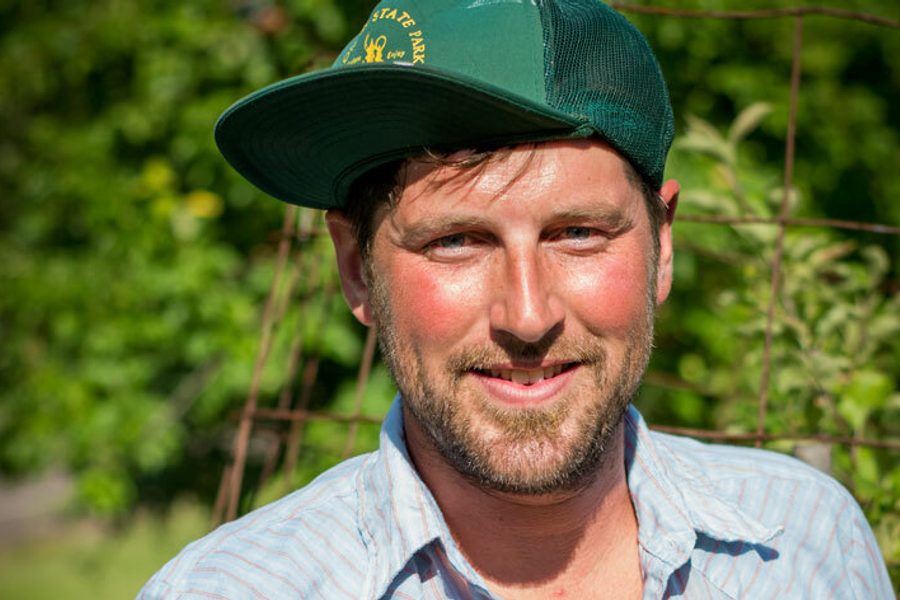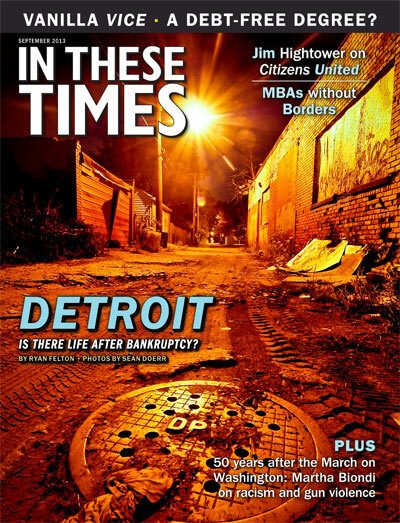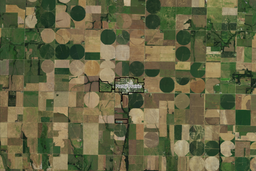
La Pointe, Wis. — About half way down Middle Road, on Madeline Island in Lake Superior, an apple tree marks the driveway into Jamie Anderson’s farm. Depending on the time of year, the 5-and-a- half acres offer a scene of dormant tranquility or one of churned earth, roaming chickens and rock-and-roll-accompanied agriculture-in-progress. The island’s economy is largely based on summer tourism. For three months each year, an influx of visitors sustain themselves with groceries hauled over from the mainland or eat at one of the island’s seasonal restaurants. But Anderson, 30, is part of a small year-round community that’s reintroducing the practice of sustainable farming.
“I set out to be self-sufficient,” says Anderson. “I wanted to grow the kind of food that I want to eat, without pesticides or patents. But I also knew there was a market for what I was doing in this community. Good food is good for everybody. The island has a history of producing food and the people who live here want the farm to work. That keeps me motivated. But, to be clear, the ultimate goal is to financially support myself by farming.”
Living in Northern Wisconsin on a 14-by-3-mile island isn’t a casual undertaking. Winter remains an unpredictable force here — one that requires a kind of acceptance that borders on complete surrender. Its duration varies to the point that the first frost can come as early as September 5 and the last as late as June 21. This can (and does) toy with the average 106-day growing season as much as the collective resident psyche. And while the same can be said of the Northwoods generally, the 2-and-a-half miles of Lake Superior that separate Madeline Island from the mainland command a unique, more isolated, living arrangement.
Anderson purchased the property from a friend in 2008. At the time, he was completing degrees in sustainable energy and geography at the University of Montana in Missoula. He would farm until late August and then head west back to school. His academic downtime was spent reading about organic farming and formulating his plan of attack for the following spring. When classes ended in May, he would fill his 1992 Subaru with how-to books, work clothes and two dogs — Amelie, a Labrador, and CiCi, a beagle — and drive the 1,300 miles back to the island.
His land included two run-down, uninhabitable structures: the original farmhouse, built sometime in the 1880s, and a large barn built a few years later. With his priorities rooted in farming, not carpentry, Anderson acquired a medium-sized trailer that he placed farther back on the lot. The property was also home to three apple trees.
The trees, remnants of an orchard and unmistakably old themselves, sparked an immediate interest. One tree in particular, though clearly still alive, looked the worse for wear. Its massive trunk was severed three-quarters of the way up, but a thick branch jutted out one side determined to carry on, horizontally if necessary. Before any plant could be put in the ground, Anderson had to address the 40 years of uninterrupted overgrowth and decades of accumulated debris that covered the land. The nature of any island is such that once anything is brought across the water, it will remain until a calculated effort is made to remove it. Things have a way of stacking up. Rusted truck parts, chunks of concrete, and tightly spaced rows of spruce trees — remnants of a paper venture abandoned in the late 1960s — crowded the area he would need to plant. Getting the land ready would take time. It would also take help.
Anderson, not unlike Tom Sawyer, possesses the ability to encourage friends to work without realizing they’re working. Days spent hauling brush into a burn pile, for example, culminate in bonfires so big their orange glow can be seen from the mainland. The evenings that follow have a way of making people forget they spent a full day clearing half an acre. It’s a testament to what can be accomplished with a chainsaw, friends, hard cider and an iPod hooked into a job-site stereo.
The farm’s pre-production phase ended in the spring of 2010, when Anderson obtained a 24-by-48 foot “hoop house” — a semi-circular tunnel, covered with a clear polyethylene skin that allows the grower to better control temperature and humidity and, when prop- erly enclosed, discourage insects. Built with help from a $2,500 USDA grant, the hoop house was part of an Obama administration initiative to aide small farmers by extending the growing season in colder climates, while reducing the need for pesticides. The grants were available in 38 states.
With the hoop house installed, Anderson began a trial run of peppers, then tomatoes, assorted greens, chives, carrots, onions and other vegetables. His expenses were partly covered by 10 islanders, who invested in the Community Supported Agriculture (CSA) program Anderson set up. CSAs, an estimated 6,000 of which exist in the United States, allow a farmer to gauge community interest before the growing season starts and receive payment up front. Individuals who participate can be certain the money they spend is being directly invested back into their community. In a global economy, the transparent simplicity of such an exchange has its appeal.
In Anderson’s case, the CSA members received weekly deliveries of whichever produce was ready to pick and, at the end of the season, a chicken.
“Eating locally when I have the chance is important to me — more important than eating organically,” says Margaretta Kusch, an employee of the island historical museum and member of Anderson’s CSA. “I do see the global food system as unsustainable. Between fuel costs, our susceptibility to pesticides and a loss of nutritional diversity, investing in an alternative where I live makes sense. But aside from being ethically right, providing food for a community is community building.”
With production underway, Anderson was able to shift his attention to the three apple trees that remained from the farm’s earlier days. Driven by a mix of practicality and sentiment, his goal was to produce more food while protecting the biological diversity he’d inherited. With possible genetic variations ranging in the tens of thousands, every characteristic of a particular apple (from its shape, sweetness, durability and color) determines whether or not the apple is commercially grown.
Inspired by a photograph and intrigued by a copy of Michael Pollan’s The Botany of Desire: A Plant’s Eye View of the World, Anderson began teaching himself the ins and outs of apple farming. Pollan’s book traces the apple’s history from its ancestral home — an ancient forest in Kazakhstan — to its current commercial incarnations. The author explores civilization’s impact on biodiversity and vice versa.
“This area is a micro-climate — one that’s uniquely suited for growing apples,” says Anderson. “Where else in Wisconsin or Minnesota do you find 19 orchards so close to each other?” he asks, referring to the neighboring orchards on the mainland that, for the past 51 Octobers, have hosted The Bayfield Apple Festival.
Apples, like people, reproduce sexually. This means that if you were to find yourself enjoying a particular kind of apple so much that you wanted to make more, and you planted a seed from that apple, you stand almost no chance of the new apples being like the one you went to all that trouble to reproduce.
An orchardist is able to ensure that he gets the same fruit over and over again by a process called grafting. This involves cutting and fusing part of an existing tree to a compatible root system — either another existing tree (a single tree is capable of producing multiple varieties of apples at the same time) or, if the grower wants to start a new tree altogether, starting with a fresh rootstock. The part cut from the plant the grower wants to graft is called a scion. The method’s origins are thousands of years old, but didn’t gain commercial traction in North America until the 19th century. We need only look at the 5 to 10 varieties of apples found in grocery stores to understand the current scope of the practice. But while commercial grafting guarantees the same sweet honey crisp every time, the market dominance of such varieties threatens to undermine the shrinking world of apple diversity.
For Anderson, determining the exact varieties of heritage apple he acquired wasn’t the point. The simple realization that his trees were intentionally planted a long time ago, combined with the fact they couldn’t readily be found anywhere else (least of all a grocery store), made preserving them important.
“I was given a picture of the farm taken in 1963. At that time there were no spruce trees like there are now, but there were 17 apple trees. Seventeen! Now there are three,” says Anderson. “They have a place in this community, and that’s why I’m trying to save them.”
Because his main objective was to produce more of the trees he already had, he would be planting scions grafted to new rootstocks. In the spring of 2012, when Anderson had a solid understanding of the general concept, he purchased rootstocks from a local nursery, selecting a semi-dwarf variety suited for the island’s clay-rich soil. The best time of year to attempt grafting is early spring, before the plant wakes up and starts budding. So Anderson began cutting scions from the oldest of his trees.
Recognizing that it would probably be a numbers game, he started with the three original trees on his property. But he didn’t stop there. Confident that at least some of his attempts to save each tree would take, he began asking about other trees on the island. Responses like: “My grandmother used to use this one to make pies” and “This apple is pretty bitter, but it might make a good cider” and “This one will last for months if picked at the right time” were enough for Anderson to ask if he might cut a small piece to take back to his farm. The community obliged. All told he grafted 80 apple trees that spring. Six didn’t make it, but the 74 that took should start producing fruit in a few years.
“When they do,” says Anderson. “I’ll have to figure out exactly what I’m dealing with, but this island is going to have a lot more apples. Over time, I’ll learn what each one is best used for and make them available to the community. But the trees themselves make me think of the people who brought them here in the first place. I like knowing that if the shit ever hits the fan, I saved the apples that got them through hard times.”
Eventually, Anderson intends to use his apples to make hard cider. “It’s part of being self-sufficient,” says Ander- son. “I enjoy drinking it. As long as I have the ingredients, I have no excuse not to try making my own. There are plenty of apple varieties that don’t look or taste the way people have come to expect, so they get commercially avoided. I hope I have some. An ugly apple can make a great cider.”
Though hard cider remains a crowd favorite at the Bayfield Apple Festival, its popularity peaked long ago. For 200 years, it was the drink of choice among North American settlers. The New England colonies consumed hundreds of thousands of gallons annually, and John Adams drank it daily for breakfast. Hard cider’s fermented nature offered some early pioneers a safe alternative to contaminated local water. With the ascendency of beer in the 19th century, cider’s popularity began to decline. But that’s beginning to change.
“When I was in Fort Collins, I heard about the Branch Out Cider Cooperative,” says Anderson. “These guys collect apples from their neighborhood and press it into hard cider. I want to try something like that. And I don’t care if mine’s not very good. I’ll know where it came from.”
Today, Anderson lives on the farm year-round and occasionally travels in the winter. Two new apple trees rest on either side of the walkway leading up to the front door. If he’s around in February, a woodstove keeps the temperature inside hovering in the mid-80s.
The old barn was knocked down carefully so Anderson could save the hemlock siding, which he sells to local contractors whose clients want the cachet of really old barnwood. The land where the barn once stood has been fenced off and tilled into rows. The old trailer he used to live in has been joined by another and is now home to volunteers who show up in the spring and summer from the World Wide Opportunities on Organic Farms. (Anderson’s is one of 34 Wisconsin farms that participate in this international organization.) The group connects young people with farmers who provide room and board in exchange for labor. In the off-season, Anderson’s trailers are there for the buddy who came over to help out and wound up drinking too much cider to drive home.









